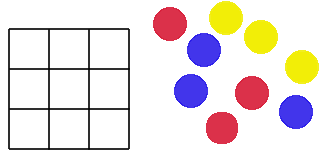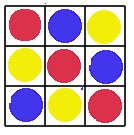Three by three
Arrange 3 red, 3 blue and 3 yellow counters into a three-by-three square grid, so that there is only one of each colour in every row and every column
Problem
Arrange three red, three blue and three yellow counters into a three-by-three square grid, so that there is only one of each colour in every row and every column.
Image

Can you arrange four different colour counters into a four-by-four square grid, so that there is only one of each colour in every row and every column?
How about five colours in a five-by-five grid? Six...?
Printable NRICH Roadshow resource.
Student Solutions
Fred
from London gave this
solution.
Image

Are there any more solutions?
Did anyone try a 4x4?
Teachers' Resources
Why do this problem?
This activity is good for encouraging children to develop their own strategy for solving a problem, and for articulating this to others.
Possible approach
The main task for the teacher is to make sure the children understand what the 'rules' of the problem are. This could be achieved by using some coloured objects, such as blocks or pieces of paper and a large 3 x 3 grid so the class can easily see it. Ask a child to choose a colour to put in the first box, then ask another to put a different colour in the next box of the row. Now ask the
children which colour must go in the last box so that all three colours have been used - that is, no colour appears twice. This procedure could be repeated for a column. (This demonstration also serves to suggest a possible strategy for working through the problem). Check their understanding by randomly arranging the coloured objects on the grid and asking them what is wrong with the rows and
columns.
Provide each child with his/her own grid and counters to work on the puzzle. Challenge children who find early success by asking them if they can find three different solutions so that there is a different colour counter in the centre of the grid each time. Ask the children to draw their solutions onto the grid and compare it with other solutions.
Encourage discussion about similar-except-rotated solutions, and truly different solutions.
Key questions
Tell me about how you are trying to solve this challenge.
Possible extension
The problem can be extended by adding a fourth colour and using a 4 by 4 grid. An additional challenge is to ensure that the main diagonals are also free of repetitions.
